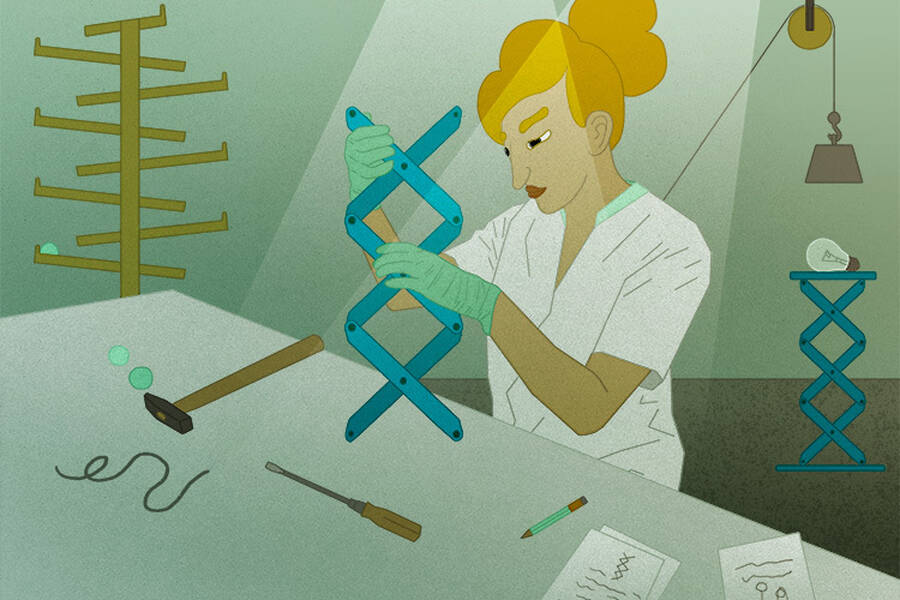Is this simply an example of our all-too-human desire to adopt the latest technologies?
Not exactly. The phenomenon is actually an example of what researchers call substitution, since most customers were likely purchasing a new phone to replace an existing one. And unlike studies of technology adoption, the dynamics of substitution aren’t well-understood, says Ching Jin, a postdoctoral fellow at Kellogg and at the Northwestern Institute on Complex Systems.
“There is another side to the story,” Jin says. “It’s not only about buying something new; we’re abandoning something old.”
In a recent study, Jin and coauthors, including Dashun Wang, an associate professor of management and organizations at Kellogg, analyzed the substitution of mobile phones and found a surprising result.
Adoption-centered models suggested that early sales of a new phone model—say, during the first six months after release—should increase exponentially. But instead, the researchers saw two distinct features that didn’t follow this pattern. First, for a brief period immediately after release, sales grew faster than they should have if they were following an exponential pattern. Second, that initial burst was followed by a substantial slowdown.
In other words, growth was faster, and then slower, than expected.
After finding this to be true for cell phones, the researchers went on to study other types of substitution. They found that this pattern—known as a power-law function—also appeared in substitutions of cars, apps, and even the scientific fields people chose to study.
“It’s a law not in just one system,” Jin says. It seems to be “a universal pattern.” The researchers speculate that the results might apply to other types of substitution, such as switching to renewable energy, green products, or a healthy diet.
This model of substitution’s growth pattern could be used to help companies predict future sales, according to the researchers, who also include Chaoming Song at the University of Miami and Johannes Bjelland and Geoffrey Canright at Telenor Group.
“If we really want to understand how you buy something new, you must understand the whole picture,” Jin says.
Explosive Growth
There’s been much previous research into diffusion in other contexts, such as the spread of viruses and human behaviors. But Wang, Jin, and their collaborators realized that many of those studies were actually looking at substitution. So, they wondered: Did substitutions follow the same pattern as other diffusions?
To answer that question and quantify the process more precisely, the team obtained a high-resolution mobile-phone data set. The data, from a telecommunications company, included anonymized records of 3.6 million people’s phone usage in Europe from 2006 to 2014. Among other things, the records showed when a customer started using a new phone model. Based on that data, the team tallied sales of 885 types of phones during the first six months after their release.
The researchers were surprised to find that sales didn’t follow the exponential growth pattern predicted by most traditional diffusion models. Initial sales rose more sharply than expected, showing “explosive growth” when a product was introduced, the team writes. And after that burst of activity, “the number of users grows much more slowly than what exponential functions predict.”
In other words, the early excitement wears off.
A better formula for estimating the early growth pattern follows a power law, Wang says. The team “was shocked to discover this because this pattern is rare in social systems, such as the spread of disease.”
So, this was a new kind of diffusion pattern, one that is very different from traditional diffusion models. This discovery prompted the researchers to ask if it may have something to do with substitution.
A Fingerprint for Substitution
To dig deeper, they decided to examine other types of substitution.
The team used three additional data sets. One contained sales of 126 types of cars in North America from 2010 to 2016. This was a clear example of substitution; when people buy a new car, they generally get rid of their old one.
The second included data on daily downloads of about 2,600 smartphone apps for two months in 2016. This represents a hybrid substitution system. When consumers download new apps, they don’t necessarily do so to replace old ones, but they may spend less time on older apps and eventually delete them to make space on their phones.
And the third data set contained records of research papers from about 6,400 scientific fields published from 1980 to 2018. This also represented a hybrid substitution system. Scientists can study more than one topic simultaneously, but their time is limited, so the number of fields they can work in is finite. That means they may stop research in some fields as they move on to others, creating a substitution.
The researchers defined the period of “early growth” as four months for cars, one week for apps, and 18 years for scientific fields. In all three cases, they found a similar power-law pattern during the early growth period.
“These domains are obviously very different from one another, yet somehow they all seem to show a similar kind of pattern, which begs the question of why,” Wang says.
In general, the team found three key mechanisms that influence whether users may switch from one product to another at any given point in time. And these three mechanisms together can produce the power-law pattern the researchers observed in the early growth period.
First, the probability of replacing a product depends on the propensity to switch from one item to another. For example, a customer is likely to switch from an iPhone 4 to iPhone 5 because the new model is very similar to the old one. Similarly, a scientist might change focus from molecular biology to bioinformatics but probably not to condensed-matter physics; such a substitution would be too big a leap.
Second, the likelihood of replacing an item depends on that item’s popularity. The more successful the product, the quicker the growth. In the case of scientific fields, popularity could be represented by how many scientists are conducting research related to the fields.
And third, substitution depends on how recently the item was released. Immediately after release, a new model generates a lot of excitement, causing the quick burst of initial growth. But other products then displace it, contributing to the slowdown in the latter part of the early growth period. Again, with science, this would mean a new “hot” field enters the picture and grabs researchers’ interest.
Testing the Boundaries
Understanding this phenomenon could help organizations better predict long-term growth of certain new products and practices, the team says.
In fact, the researchers developed a mathematical model of the process that could generate those estimates. The model can’t predict the very early stages of growth. However, if a firm tracks initial sales, the model can use that data to figure out some key parameters, including the level of anticipation for the new item, the likelihood that consumers will switch, and how quickly the product will become obsolete. Based on that information, the model can then predict future sales.
“Decision-makers may benefit from these early figures and other related signals, helping them to assess whether the product’s fit, initial excitement and shelf life are meeting expectations and adjust tactics accordingly.” Wang says.
The researchers caution the findings may not apply to products that don’t entail substitution, such as an entirely novel gadget that has no predecessor, or purchases like clothes, that don’t necessarily replace something else. In those cases, traditional models of exponential growth may fit better. Nevertheless, the team hopes that other researchers will study substitution of additional items to test how universal the pattern is.






